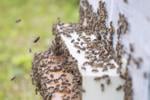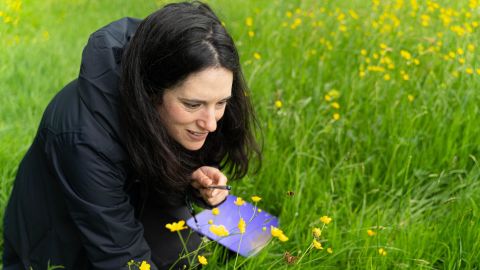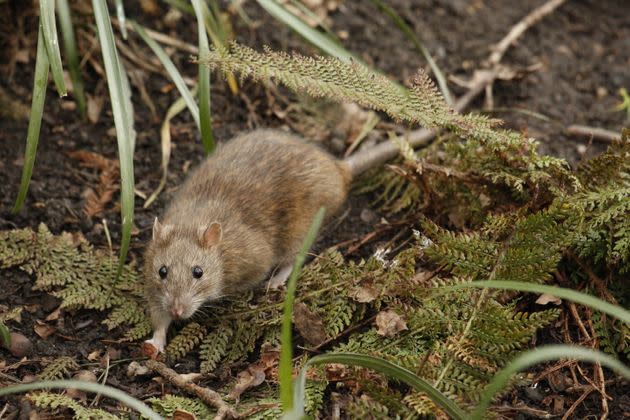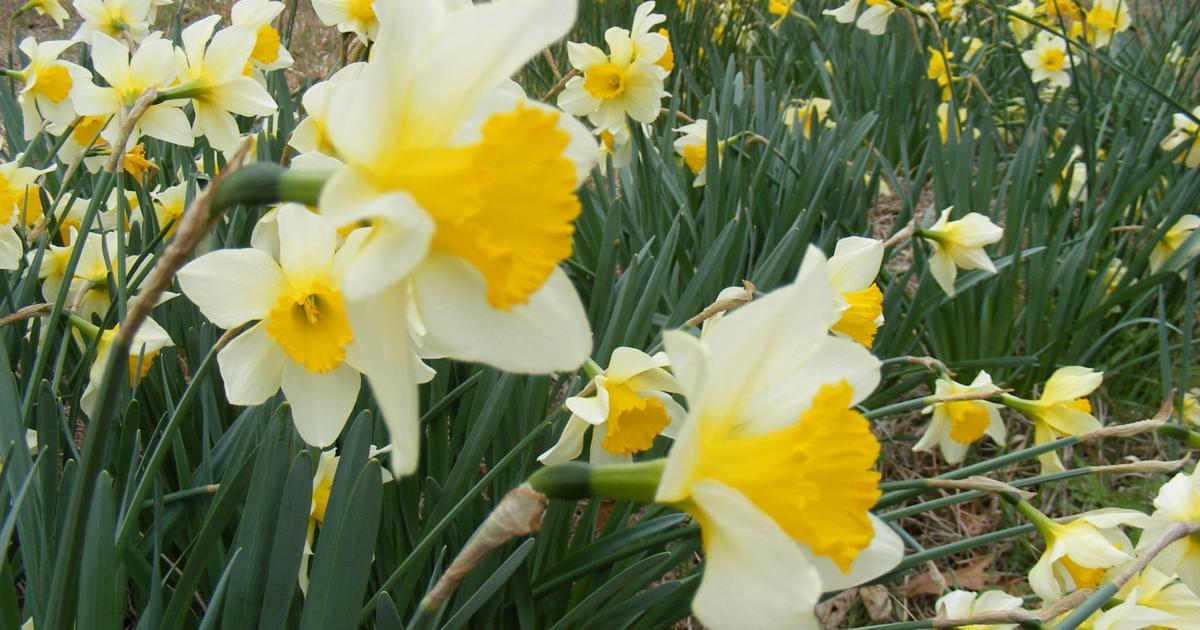PHILADELPHIA — The honeybees looked perfectly healthy, buzzing about their boxy wooden hive on a warm autumn day in central Pennsylvania.
Elizabeth Capaldi suspected otherwise.
Clad in a protective white suit and hat, the biologist reached out with a gloved hand to capture one of the insects in a small vial, then took it back to her Bucknell University laboratory to dissect its brain.
Her colleague David Rovnyak later placed a sample of the bee’s innards inside a large metal cylinder and pelted it with high-frequency radio waves — a type of scanning technology that revealed the amounts of certain telltale chemicals within.
A honeybee hovering at a flower.
Their goal: to identify early warning signs that a bee is under stress, so that beekeepers can try to rescue a threatened hive before it’s too late.
People are also reading…
Honeybees have been in decline for decades, causing headaches and higher costs for farmers who depend on the insects to pollinate their apples, almonds and 130 other fruit, nut and vegetable crops. The issue made headlines in 2006 with the emergence of a mysterious new phenomenon called colony collapse disorder, but the broader downturn in bee health was underway well before that, and it continues to this day.
The causes include climate change, pesticides, and disease, said Capaldi, who studies insect behavior and neuroscience at the liberal arts university in Lewisburg. In bad years, the combination of insults can wipe out more than half of a beekeeper’s colonies.
“Honeybees are suffering,” she said. “All of these factors have united together to create a stressful environment for honeybee colonies across the country.”
She and Rovnyak, a chemistry professor at Bucknell, realized five or six years ago that the problem might lend itself to an interdisciplinary solution. The pair joined forces with colleague Marie Pizzorno, an expert in viruses — as one factor in the insects’ decline is a virus that deforms their wings.
They want to to identify chemical stress indicators that become elevated in a bee’s brain months before the insect displays any outward signs of decline.
The cylindrical device Rovnyak uses to detect these substances, called a spectrometer, would be impractical for any beekeeper or farmer. But once the researchers determine which chemicals are the best predictors of bee health, they want to develop a low-cost test that could be deployed in the real world.
Double the cost
Every spring, just as the apple blossoms are starting to bloom, a flatbed truck rolls up to Hollabaugh Bros. farm in the middle of the night, laden with 100 honeybee hives.
Workers set up the boxy containers across 150 acres that produce more than 50 varieties of apples, said Ellie Hollabaugh Vranich, assistant business manager of the farm in Biglerville, just north of Gettysburg.
“We try to get them spread out while it’s still dark, before the bees wake up,” she said.

Bees at the entrance to a hive. Honeybees have been in decline for decades, causing headaches and higher costs for farmers who depend on the insects to pollinate crops.
A decade ago, the farm rented the hives for $50 apiece. A few years ago, the price rose to $60, and this past spring, it was $100, for a total of $10,000, she said.
Beekeepers have cited a variety of reasons for the increases, such as higher fuel costs and disruptions related to the COVID-19 pandemic. But every year, a major factor in higher costs is that many colonies don’t survive the winter, meaning beekeepers must scramble to raise new ones in time for the growing season.
“You can’t just manufacture a bee on a processing line in a factory,” Vranich said. “They have to be bred and given time to develop new hives.”
Experienced beekeepers such as Capaldi, the Bucknell scientist, can often tell when a hive is starting to fail simply by looking at it. Perhaps the insects haven’t amassed long-term stores of honey, subsisting instead on liquid nectar. A lack of a brood is another warning sign.
But by that point, it might already be too late.
A year ago, Capaldi judged that her eight hives at Bucknell were under stress, likely because the fall asters and goldenrods had produced less nectar than usual. So throughout the winter, she supplemented the insects’ food with sugar.
Even so, just two of the hives survived.
Finding the culprits
The first sign of trouble for the insects came in the 1980s with the introduction of a parasitic mite from overseas, said Pizzorno, the Bucknell virologist.
Relative to the size of the honeybee, these parasites, called Varroa destructor, are enormous.
“It’d be like having a tick on your body that’s the size of a dinner plate,” she said.
Scientists later would discover that in addition to inflicting harm directly, the parasites also transmitted a virus to the honeybees that deforms their wings.
Researchers also have established that climate change affects the bees in a variety of ways, Capaldi said. Early warm spells or unusual rain patterns can cause flowers to bloom too early and disappear by the time the insects are looking for nectar.
Certain pesticides and other practices of large-scale industrial agriculture also can add to the stress, she said. That includes the way the bees are deployed, trucked from farm to farm where they subsist on one crop for days at a time.
Increasingly throughout the 1990s, beekeepers reported that some of their colonies did not survive the winter. Then in 2006, beekeepers discovered that some colonies were dying in an unusual way. Instead of dying in or near the hive, bees were simply vanishing, apparently flying off to die elsewhere.
In the meantime, significant fractions of colonies keep failing every winter — 30% one year, 40% or 50% the next, according to surveys by the nonprofit Bee Informed Partnership. For now, breeders have kept up with the demand for new colonies. But at some point, maybe they won’t, Rovnyak said.
“It just seems to be getting more and more challenging every few years,” he said. “And there’s no sign this is stopping.”
25 endangered animals that only live in America
25 endangered animals that only live in America

The Endangered Species Act is a landmark conservation law that has brought wildlife threatened by habitat destruction, climate change, and other issues back from the brink of extinction—the iconic Bald Eagle is one of the most well-known examples.
In 2019, the Trump Administration rolled back several major protections outlined in the Endangered Species Act. These changes included banning blanket protections for newly threatened species and allowing cost to be a consideration when evaluating what it would take to save at-risk species. While in office, Trump took more than 100 legislative actions favoring business over the environment. In July 2022, U.S. District Judge Jon Tigar, presiding in Northern California, threw out the Trump-era changes, restoring critical protection for threatened species.
More than 1,300 species in the U.S. are listed as either endangered or threatened under the Endangered Species Act. Some of these animals are found nowhere else in the world. Stacker compiled a list of 25 endangered animals that are only found in the United States using the 2022 International Union for Conservation of Nature Red List and the U.S. Fish and Wildlife Service Endangered Species list.
All animals on this list are classified as either Endangered or Critically Endangered by the IUCN, and classified as either Endangered or Threatened by the federal government. While the U.S. Fish and Wildlife Service identifies critical habitats and provides legal protections for endangered species, the IUCN helps raise global awareness through data collection, analysis, fieldwork, advocacy, and fundraising.
Salt marsh harvest mouse

– Scientific name: Reithrodontomys raviventris
– Red List status: Endangered
– Geographic range: California
The salt marsh harvest mouse was found around the Bay Area until relatively recently, but its habitat has become extremely fragmented. Because of human development, populations of the mouse are isolated from one another and cannot breed properly.
Utah prairie dog

– Scientific name: Cynomys parvidens
– Red List status: Endangered
– Geographic range: Utah
The Utah prairie dog was declared endangered in 1973. However, over the last 30 years, the population has been stable to increasing, and the species is now federally recognized as threatened rather than endangered. Threats like urban expansion, climate change, and resource exploration remain, but the prairie dog has recovered strongly.
Red wolf

– Scientific name: Canis rufus
– Red List status: Critically endangered
– Geographic range: North Carolina
Red wolves were once found along much of the Southeast, but habitat destruction, hunting, and urban encroachment have dwindled their range to the point that they are only found in North Carolina. They’re one of the most endangered canids on Earth. Red wolves are also highly endangered because of interactions with coyotes, which can hurt the species’ long-term viability.
Kauai cave wolf spider

– Scientific name: Adelocosa anops
– Red List status: Endangered
– Geographic range: Hawaii
The Kauai cave wolf spider is a highly unusual spider that can only be found in caves in the Koloa district of Kauai, Hawaii. Wolf spiders usually utilize their vision rather than webs to catch their prey, but the Kauai cave wolf spider is unique because it is eyeless, relying only on swift motion to hunt. Because they have such specific habitat needs, the cave wolf is highly vulnerable to habitat destruction from construction, human visitation, and other sources.
Laysan duck

– Scientific name: Anas laysanensis
– Red List status: Critically endangered
– Geographic range: Hawaii
Ducks don’t immediately come to mind when we consider an endangered species, but this particular one is. The Laysan duck, once found all over the Hawaiian islands, now has a population only found on Laysan Island and on a wildlife refuge at Midway Atoll.
Yosemite toad

– Scientific name: Anaxyrus canorus
– Red List status: Endangered
– Geographic range: California
The Yosemite toad, endemic to the Sierra Nevada Mountains in Northern California, is covered in warts; the females also have splotches all over their bodies. This species of toad walks rather than hops. They are particularly vulnerable to habitat destruction and are estimated to survive in only 50% of the species’ historically known habitats.
Gunnison sage-grouse

– Scientific name: Centrocercus minimus
– Red List status: Endangered
– Geographic range: Colorado, Utah
The Gunnison sage-grouse is an unusual species of bird found only in the Southwest. They face threats from a variety of sources, but their habitat has been largely ravaged by oil and gas drilling. Environmental groups are fighting hard to protect the animal’s remaining habitat from further drilling.
Fanshell

– Scientific name: Cyprogenia stegaria
– Red List status: Critically endangered
– Geographic range: Tennessee, Kentucky, Virginia
The Fanshell, a river mussel, has been severely impacted by human activity like dredging, mining, and water pollution. Water conservation activities and erosion prevention are both key to keeping the mussel from disappearing.
Giant kangaroo rat

– Scientific name: Dipodomys ingens
– Red List status: Endangered
– Geographic range: California
Giant kangaroo rats are the largest species in their family. They got their name because they stand up on their hind feet and hop to move, like a kangaroo. They create complex burrow systems that sometimes have more than five separate entrances. In addition to habitat fragmentation, this species is under threat from rodenticide use in agricultural operations.
Delta green ground beetle

– Scientific name: Elaphrus viridis
– Red List status: Critically endangered
– Geographic range: California
This beetle has a range of only about 7,000 acres in Solano County, California. There are natural gas reserves in the beetle’s habitat, so natural gas exploration could further threaten it. Because it is unusually colorful, it could also be a target for illegal collectors.
Jollyville Plateau salamander

– Scientific name: Eurycea tonkawae
– Red List status: Endangered
– Geographic range: Texas
This unique salamander spends its entire life underwater. It was only discovered in 2000, but already its population has declined dramatically due to the sensitive nature of these amphibians. The Jollyville Plateau salamander is highly threatened by development, which groups like The Center for Biological Diversity fight in areas known to be inhabited by this species.
California condor

– Scientific name: Gymnogyps californianus
– Red List status: Critically endangered
– Geographic range: California, Arizona, Utah
Condors are the largest flying birds in North America. Their wingspan is nearly 10 feet from tip to tip. After they nearly went extinct, the remaining 10 wild condors were captured in 1987; reintroduction began in 1992. The condor population has grown to exceed 500 birds today.
American burying beetle

– Scientific name: Nicrophorus americanus
– Red List status: Critically endangered
– Geographic range: Arkansas, Kansas, Massachusetts, Nebraska, Ohio, Oklahoma, Rhode Island, South Dakota, Texas
Burying beetles survive off of the carcasses of dead animals, which they bury in the ground. Biologists aren’t sure what has led to their rapid decline, bt it is possible that it has been caused by declines in other species that they rely on to eat.
Squirrel Chimney Cave shrimp

– Scientific name: Palaemonetes cummingi
– Red List status: Critically endangered
– Geographic range: Florida
This tiny, translucent shrimp has only been found in a single sinkhole in Florida. Because they are so rare, very little is known about them at this point.
Crested honeycreeper (Akohekohe)

– Scientific name: Palmeria dolei
– Red List status: Critically endangered
– Geographic range: Hawaii
The crested honeycreeper, known in traditional Hawaiian as ‘Ākohekohe, was once found on both Maui and Molokai but is now only found on Maui. It is known for its acrobatic movements and how it runs across treetops.
Red Hills salamander

– Scientific name: Phaeognathus hubrichti
– Red List status: Endangered
– Geographic range: Alabama
The Red Hills salamander is unusually large, growing to near 1 foot long. Unfortunately, its range is very limited. In fact, it is the only terrestrial vertebrate entirely confined to the state of Alabama, where it is the official state amphibian.
Louisiana pine snake

– Scientific name: Pituophis ruthveni
– Red List status: Endangered
– Geographic range: Louisiana, Texas
The Louisiana pine snake, one of the rarest snakes in North America, is known for its large eggs. This non-venomus constrictor rarely appears in the wild anymore, but when it does, it lives out its days in the warren of tunnels created by pocket gophers, which it eats.
Woundfin

– Scientific name: Plagopterus argentissimus
– Red List status: Critically endangered
– Geographic range: Arizona, Utah, Nevada
Woundfins are tiny minnows that once occupied much of the Colorado River Basin. But because of habitat destruction, invasive species, and other issues, its populations have dwindled significantly. Increased water temperatures are one of the biggest threats to the fish.
Alabama red-bellied turtle

– Scientific name: Pseudemys alabamensis
– Red List status: Endangered
– Geographic range: Alabama
Named for its bright underbelly, which can be red or yellow, this turtle makes its home in freshwater rivers, ponds, and bayous. Unfortunately, when the turtles come onto land to lay eggs, they are a target for drivers who don’t see them. The Alabama Department of Transportation has built fences to keep them off highways and has signs on roads during hatching season to keep them safer.
Bruneau Hot springsnail

– Scientific name: Pyrgulopsis bruneauensis
– Red List status: Critically endangered
– Geographic range: Idaho
This unusual snail is found only in hot springs in Idaho. It is vulnerable because of this, mainly because of groundwater withdrawal from agriculture. It has also fallen prey to some introduced species of fish.
Mountain yellow-legged frog

– Scientific name: Rana muscosa
– Red List status: Endangered
– Geographic range: California
These frogs are usually found within just a few feet of a water source. They mainly appear at high elevations, ranging from 4,500 to 12,000 feet. Unfortunately, fish farming has been a major threat to the frogs, as fish stock compete with them for food.
Flattened musk turtle

– Scientific name: Sternotherus depressus
– Red List status: Critically endangered
– Geographic range: Alabama
It can take this tiny turtle up to 60 years to reach its full length—which is only 12 centimeters. Habitat fragmentation has had a major impact on the turtle, although the state of Alabama now protects it, and recovery efforts are underway to restore its habitat.
Coachella Valley fringe-toed lizard

– Scientific name: Uma inornata
– Red List status: Endangered
– Geographic range: California
This lizard has adapted to life in the harsh desert. It spends most of its daylight hours “swimming” in the sand: burrowing underneath during the worst of the heat. Its biggest threat is human development in its habitat.
Northern Idaho ground squirrel

– Scientific name: Urocitellus brunneus
– Red List status: Critically endangered
– Geographic range: Idaho
This rare squirrel relies on large amounts of grass and seeds to fatten up for its long winter hibernation. Fire suppression efforts have greatly reduced its food supply, leading to population decline. While the species recovery pattern is largely unknown, there are an estimated 2,200 animals across 54 populations in Idaho.
We’re always interested in hearing about news in our community. Let us know what’s going on!
Go to form
Be the first to know
Get local news delivered to your inbox!









